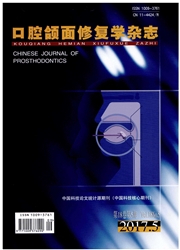

 中文摘要:
中文摘要:
目的:测量上颌骨缺损患者手术前后咀嚼运动时脑血流的变化,探讨上颌骨缺损所致咀嚼功能降低与脑血流变化的关系。方法:选取因肿瘤手术切除将导致上颌骨缺损的患者16例,应用经颅多普勒超声探测仪,测量其手术前不咀嚼、空咀嚼5min、10min三个时段的大脑中动脉(MCA)收缩期峰流速(Vs)、舒张期末峰流速(Vd)、平均峰流速值(Vm)。在患者手术后约2个月(永久赝复体修复前),再分别测量相应的数值。采用SPSS13.0进行重复测量数据的方差分析。结果:手术因素对于Vs、Vd的影响差异无统计学意义(P〉0.05),而对于Vm有明显的影响(P〈0.05)。时间因素对Vs、Vd、Vm的影响差异有统计学意义(P〈0.05)。随着咀嚼时间的延长,峰流速均数增加。时间因素与手术因素(即术前和术后)对Vs、Vd、Vm的影响有交互作用(P〈0.05)。结论:切除术前和术后,空咀嚼运动均有促使其大脑中动脉脑血流量增加的作用,且随咀嚼运动时间延长(累计咀嚼10min),脑血流速呈加快趋势。与术前相比,切除术后咀嚼运动时大脑中动脉血流量降低。
 英文摘要:
英文摘要:
Objective: To study cerebral blood l ow changes during mastication in maxillary defect patients after surgery. Methods: 16 patients with maxillary defects due to tumor resection were selected. Shrink of peak velocity(Vs), end-diastolic peak velocity(Vd), average peak flow values(Vm) of middle cerebral artery(MCA) were measured by transcranial Doppler ultrasound detector before and after surgery for about two months(before restored with permanent prosthesis) including three periods respectively, i.e. 0min, 5min, 10 min after empty mastication. Variance for repeated measures data was analyzed with SPSS 13.0. Results: Surgical factors had no signii cant impact to Vs, Vd(P〉0.05), and had a signii cant impact to Vm(P〈0.05). Time factors had a signii cant impact to Vs, Vd and Vm(P =0.0000.05). As mastication time increased, the mean of peak l ow increased. There were the interaction before time factor and surgical factors(ie, before and after surgery), P =0.0000.05. Conclusion: Empty mastication can prompte blood l ow of MCA, and with mastication time prolongs(mastication cumulative form 0min to 10min), cerebral blood l ow accelerates. Cerebral blood l ow of MCA decreases during mastication after surgery.
 同期刊论文项目
同期刊论文项目
 同项目期刊论文
同项目期刊论文
 期刊信息
期刊信息
